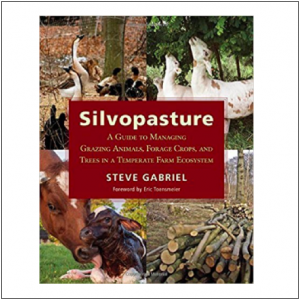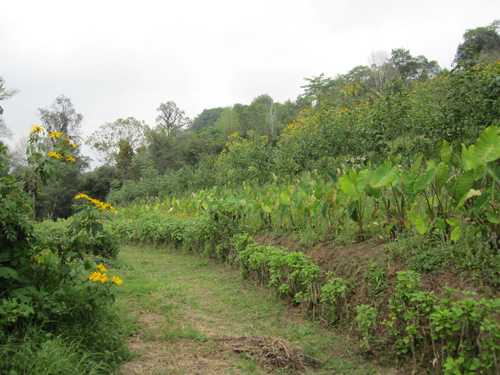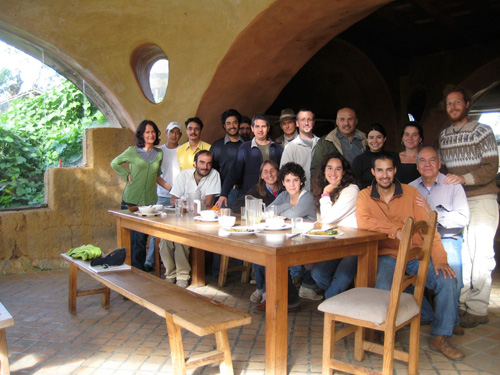This article is an excerpt from my recently published book The Carbon Farming Solution, and is part of a series that promoted my kickstarter campaign to raise funds with which I completed the book.

Industrial crops produce materials, chemicals, and energy. Some, like cotton, have been used since the dawn of agriculture. Others, like firewood, go back with our species for a hundreds of thousands of years. Few of us pause to think where cardboard, rubber, fibers, solvents and biopesticides come from.

Currently much of the materials, chemicals, and energy that support our civilization are synthesized from fossil fuels. To address climate change this needs to end, and we need to learn to do without or use renewable feedstocks (raw materials). Of the biobased renewables used now, GMO corn may be the most frequently used, for example for ethanol and bioplastics. In addition to the social and ecological problems of GMO corn, as an annual crop it contributes to the release of soil carbon into the atmosphere. We must do the opposite, developing perennial and regenerative systems that sequester vast amounts of carbon while meeting human needs.
Some industrial crops are perennial, but these are problematic as well. Plantations of pine and spruce used for paper are clear cut and destructively harvested, killing the trees and ending their carbon sequestration potential. Even non-destructively harvested perennial industrial crops are often grown in vast monocultures with devastating effects on people and ecosystems. Examples include rubber and ethanol sugarcane.
Biofuels are particularly problematic. They are taking land from food production, but there simply isn’t enough land to grow close to all the energy we need. There is a role for local, small-scale production of biofuels, but the great majority of energy must come from clean sources like wind, solar and water. But you can’t make plastic from the wind!
Imagine what the role of industrial crops could and should be in a free and ecological civilization. Perennial, non-destructively harvested crops, grown in integrated polycultures with food plants, livestock and more. Decentralized production and appropriate-scale technology could provide many of the needs of civilization in a fashion that supports regional self-determination. All while substituting for petroleum and annual food crop feedstocks and actively sequestering carbon! Check out my article on industrial starch to see a case study of perennial potential.
| CATEGORY | NON-DESTRUCTIVELY HARVESTED PERENNIAL CROP TYPES | MATERIALS | CHEMICALS | ENERGY |
| Biomass | Resprouting woody plants and grasses, bamboo, crop residues | Paper, cardboard, agromaterials, biochar, insulation, natural building materials, synthetic fibers | Solvents, chemical feedstocks, resins, stabilizers, dispersants, binders and fillers | Firewood, combustibles, biogas, gasification, pyrolysis, ethanol, methanol |
| Starch | Pods, starchy fruits, nuts and seeds, starchy trunks | Bioplastics, paper, cardboard, packaging materials, plasterboard | Solvents, paints, glues, binders, coaters, stabilizers, coagulants, flocculants, textile finishing agents, chemical feedstocks | Ethanol |
| Sugar | Pods, saps, extracted sugars, fruits | Biomass products from crop residues | Solvents | Ethanol |
| Oils | Oilseeds, extracted oils | Bioplastics, biomass products from residues | Glycerin, soaps, lubricants, hydraulic fluid, surfactants, surface coatings, solvents, paints | Biodiesel |
| Hydrocarbons | Resprouting woody and herbaceous plants, saps | Bioplastics, rubber, biomass products from crop residues, asphalt | Chemical feedstocks, pharmaceuticals, virtually infinite products | Gasoline, propane, jet fuel, other hydrocarbon fuels, biogas |
| Fibers | Resprouting woody and herbaceous plants, bamboos, seed and fruit fibers, multipurpose palms | Textiles, cordage, paper and cardboard, agromaterials, bioplastics and composites, biomass products from residues, natural building materials | As for biomass | |
| Specialty products | Diverse | Cosmetics, diverse products | Soaps, waxes, resins, biopesticides, essential oils, pharmacecuticals, dyes | |










